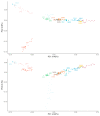The Shepherd and the Hunter: A Genomic Comparison of Italian Dog Breeds
- PMID: 37570247
- PMCID: PMC10417656
- DOI: 10.3390/ani13152438
The Shepherd and the Hunter: A Genomic Comparison of Italian Dog Breeds
Abstract
Shepherd and hunting dogs have undergone divergent selection for specific tasks, resulting in distinct phenotypic and behavioural differences. Italy is home to numerous recognized and unrecognized breeds of both types, providing an opportunity to compare them genomically. In this study, we analysed SNP data obtained from the CanineHD BeadChip, encompassing 116 hunting dogs (representing 6 breeds) and 158 shepherd dogs (representing 9 breeds). We explored the population structure, genomic background, and phylogenetic relationships among the breeds. To compare the two groups, we employed three complementary methods for selection signature detection: FST, XP-EHH, and ROH. Our results reveal a clear differentiation between shepherd and hunting dogs as well as between gun dogs vs. hounds and guardian vs. herding shepherd dogs. The genomic regions distinguishing these groups harbour several genes associated with domestication and behavioural traits, including gregariousness (WBSRC17) and aggressiveness (CDH12 and HTT). Additionally, genes related to morphology, such as size and coat colour (ASIP and TYRP1) and texture (RSPO2), were identified. This comparative genomic analysis sheds light on the genetic underpinnings of the phenotypic and behavioural variations observed in Italian hunting and shepherd dogs.
Keywords: Italian dog breeds; SNP; canine genomics; hunting dogs; shepherd dogs.
Conflict of interest statement
The authors declare no conflict of interest.
Figures





References
-
- Huson H.J. Genetic Aspects of Performance in Working Dogs. In: Ostrander E., Ruvinsky A., editors. The Genetics of the Dog. CAB International; Croydon, Australia: 2012. pp. 477–495.
-
- Serpell J. The Domestic Dog. 2nd ed. Cambridge University Press; New York, NY, USA: 2016.
-
- Brewer D.J., Clark T., Phillips A. Dogs in Antiquity. Anubis to Cerberus: The Origins of the Domestic Dog. Liverpool University Press; Liverpool, UK: 2002.
LinkOut - more resources
Full Text Sources
Miscellaneous

